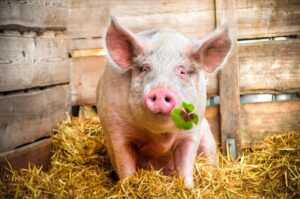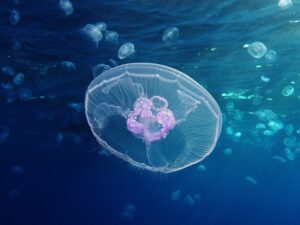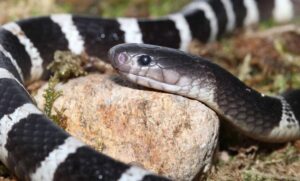Lizards, white-capped stilts, and water striders are among the animals that can run on the surface of water.
In addition to animals with incredible camouflage skills or deadly venom, Mother Nature has also “created” many creatures with superhuman abilities, such as the power to “fly” across the water’s surface. Let’s take a look at some of these Animals That Can Walk on Water with KnowAllAnimals in the article below.
1. 4 Animals That Can Walk on Water – Nature’s Amazing Balancing Act
Join us as we explore these four unique animals that can walk on water:
1.1. Basilisk Lizard
- Kingdom: Animalia
- Phylum: Chordata
- Class: Reptilia
- Order: Squamata
- Suborder: Iguania
- Family: Corytophanidae
- Genus: Basiliscus
- Species: B. basiliscus
The Basilisk lizard, also known as the “Jesus Christ lizard,” has an astonishing ability to run across the surface of the water. This unique reptile primarily lives in the tropical forests of Central America, hiding in tree hollows to regulate its body temperature.
When startled by a predator, the Basilisk lizard will often leap onto a stream or river to escape. These lizards are incredibly fast, reaching speeds of up to 8.4 km/h (5.2 mph), and sometimes even 11 km/h (6.8 mph) on water.
The reason the Basilisk lizard can run so fast on water is because of a thin membrane between its toes. When running, this membrane spreads out, creating a larger surface area and an air pocket that enhances surface tension, preventing it from sinking.
By running on its hind legs and using its tail for balance, the lizard can travel a significant distance. Once it becomes tired, the Basilisk will drop into the water and swim to the shore.
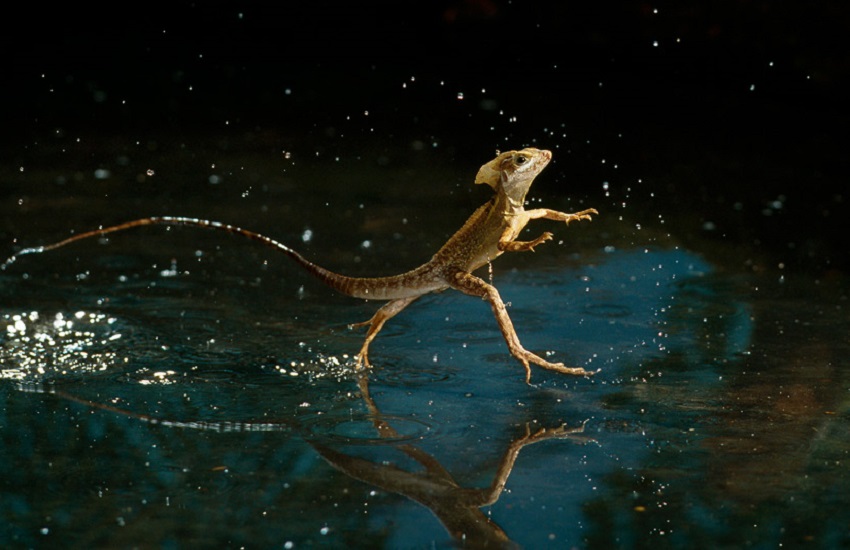
1.2. Water Strider
- Kingdom: Animalia
- Phylum: Arthropoda
- Class: Insecta
- Order: Hemiptera
- Suborder: Heteroptera
- Superfamily: Gerroidea
- Family: Gerridae Leach, 1815
Water striders (Gerris remigis) primarily live in rivers, ponds, and lakes and are considered one of the most advanced species in nature in terms of their ability to inhabit the water’s surface.
Their long, slender legs allow water striders to move easily on both land and water. Under a microscope, experts have discovered that the water strider’s legs are covered in thousands of tiny hairs, each about 50 micrometers long.
These hairs flare out into microscopic bristles that trap air, creating a cushion that separates the legs from the water and increases the animal’s buoyancy.
This air cushion also helps the water strider move quickly and maintain balance on the water, even during unfavorable weather conditions like storms.
Even though the water strider’s legs can create a depression up to 4mm deep, they don’t break the water’s surface. This extraordinary buoyancy allows the animal to bounce across the water like a rubber ball.
Furthermore, water striders can dart across the surface at a speed of up to a hundred times their body length per second. This speed is equivalent to a 1.8-meter human “swimming” at 644 km/h (400 mph).

1.3. Eared Grebe
- Kingdom: Animalia
- Phylum: Chordata
- Class: Aves
- Order: Podicipediformes
- Family: Podicipedidae
- Genus: Podiceps
- Species: P. nigricollis
The Eared Grebe (Podiceps nigricollis nigricollis) is a small diving bird found in North America, Asia, and Europe. Eared Grebes have narrow wings and a thick, waterproof coat of feathers. These features allow them to “immerse” themselves underwater or float effortlessly on the surface.
Their beaks are not very long, which allows them to easily catch crustaceans and insects. Eared Grebes have large feet with webbing that connects the front toes, and a smaller web on the back toe.
This webbing acts like a “paddle,” helping the Eared Grebe move steadily or walk on the water’s surface. Adult Eared Grebes in the breeding season have gray feathers, a darker head, and a white belly. They are quite small, measuring about 50 cm (20 inches) long and weighing 1.4 kg (3.1 lbs).
You can see these birds playing on the water in the video below.
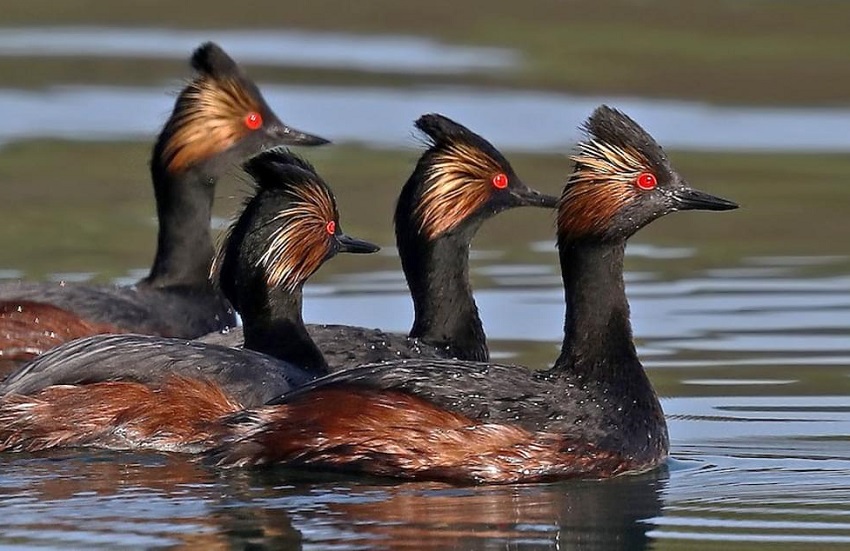
1.4. Marine Midge
- Kingdom: Animalia
- Phylum: Arthropoda
- Class: Insecta
- Order: Diptera
- Family: Chironomidae
- Subfamily: Chironominae
- Tribe: Tanytarsini
- Genus: Pontomyia Edwards, 1926
As larvae, these marine midges (Pontomyia) hide in saltwater pools, feeding on algae and rotting wood. When they mature, the male midges move across the water’s surface by standing upright on their two back legs and using their two front legs as tiny paddles to propel themselves forward.
The female midges don’t even have wings or legs; they simply float on the surface and wait for the males to come and pull them along. Further research has shown that the legs of the marine midge have a structure similar to that of the water strider—thousands of tiny hairs cover their legs, trapping air and creating a cushion that separates their feet from the water. This allows them to float and move easily on the surface.
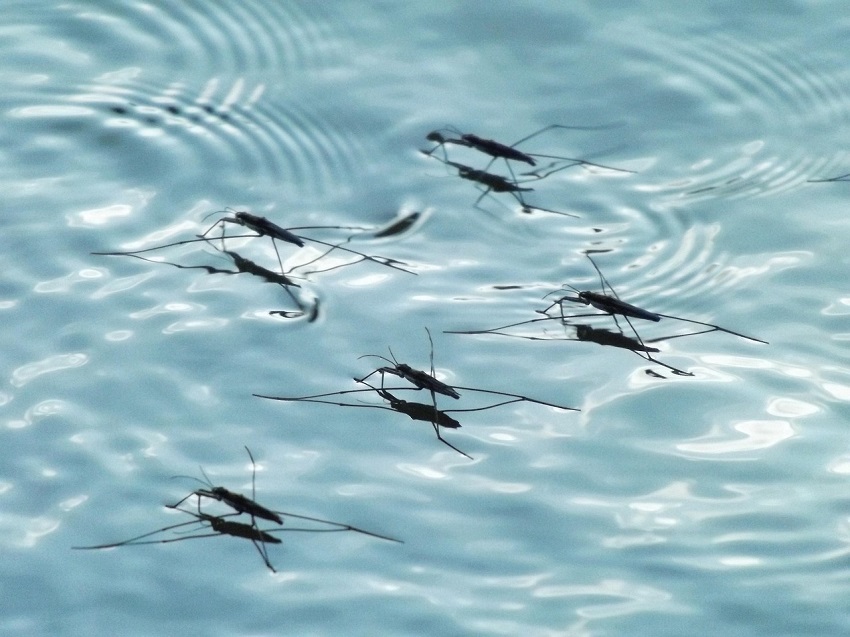
2. FAQs
1. How can some animals walk on water?
They use a combination of body structure, surface tension, and rapid movement to stay above the water without sinking.
2. Which is the most famous animal that can walk on water?
The basilisk lizard, often called the “Jesus Christ lizard,” is well known for its ability to sprint across water surfaces.
3. Are insects included among animals that can walk on water?
Yes. Insects like water striders can easily move across water thanks to their lightweight bodies and hydrophobic legs.
4. Do these animals walk on water for fun or survival?
It’s mainly for survival—such as escaping predators, catching prey, or moving quickly across their habitat.
From the lightning-fast Basilisk lizard to the slender water strider, these incredible creatures have mastered the art of “walking” on water—a skill that seems almost magical to us. This rare ability is not just a fascinating trick of nature; it is a crucial survival strategy in their respective habitats. As we learn about these unique adaptations, we gain a greater appreciation for nature’s creativity and the extraordinary ways life evolves to thrive in every corner of our planet.
Thank you for reading the article, “4 Animals That Can Walk on Water – Nature’s Amazing Balancing Act,” by Know All Animals!

